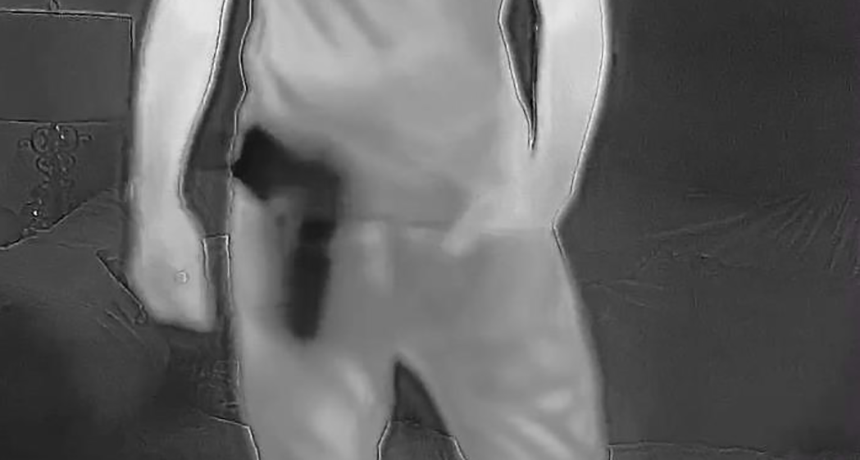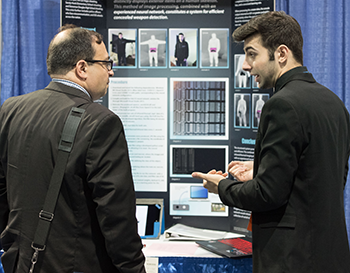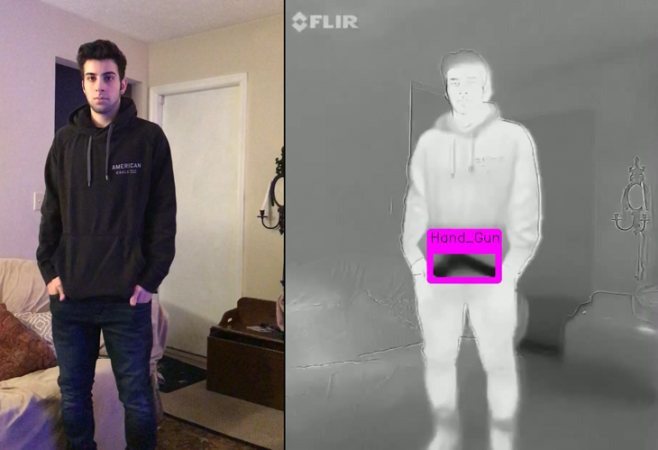Heating up the search for hidden weapons
A simple infrared-sensing camera and some fancy software can reveal the presence of a concealed knife or gun

Using thermal imagery and some sophisticated software, a Maryland teen has developed a system that can detect hidden weapons. Here, it reveals a simulated handgun tucked inside a waistband.
Andrew Karam
By Sid Perkins
PITTSBURGH, Pa. — Shootings in U.S. schools have grabbed attention throughout the past few years. And they seem to be happening more and more frequently. On average, there has been one shooting that has killed or injured someone at a school each week this year. A key to limiting such events, some people argue, is keeping concealed guns out of schools. A student from Maryland has now developed a system to reveal hidden firearms. It should even work with other weapons.

Andrew Karam, 17, has paired up a simple camera and a nifty bit of computer software. The junior at Arundel High School in Gambrills, Md., showcased his new system here, last week, at the Intel International Science and Engineering Fair (ISEF). He was among almost 1,800 finalists from 81 nations, regions and territories. They competed for about $5 million is prizes and scholarships. Nearly a third of the finalists took home some award.
Security checkpoints at airports already use weapons detectors. Some use X-rays to spot objects based on their density. That’s the same way hospitals use X-rays to distinguish bones from flesh. Other devices detect weapons by looking for changes in a magnetic field. Those changes are due to the presence of metal objects. Still other systems emit small amounts of radiation and then look for reflections that could betray suspicious objects.
Some schools have begun to use similar technologies, Andrew says. But just as at the airport, these devices are typically deployed at checkpoints that people and bags must pass through. That can turn these checkpoints into bottlenecks, he notes; they slow how quickly students can enter or leave a school. Andrew decided to instead design an entirely different type of weapons detector. It uses a computer program known as a neural network.
Such a computer program works somewhat like the human brain (hence its name). In particular, this software learns by studying examples. So, just as people can be trained to recognize suspicious images in scanning systems at airports, this program can too, the teen says. He trained its software using a toy gun. Images of it were taken with an off-the-shelf camera that can be used with cell phones. His camera cost about $300 and can be used with either iPhones or Android devices. Andrew modified the camera’s images to make a concealed weapon stand out.
Story continues below image.

How he did it
He started by programming his software to discard the visible-light components captured by his camera. The software now focused solely on the infrared (heat) wavelengths that the camera picked up. Every object has a temperature and thus emits such radiation. (Infrared radiation has a longer wavelength than visible light.) Critically, Andrew notes, infrared radiation passes through clothing and most other materials.
Next, his software transformed color photos of the toy gun into black-and-white images. This is known as a grayscale conversion. After that, the program boosted the contrast in those images. This exaggerated even small differences in temperature to readily distinguish a concealed weapon from the slightly cooler or warmer materials around it.
Andrew fed hundreds of images of the toy gun into his neural network. Each had been taken from a slightly different angle. In just five hours of computing, the software learned to recognize the gun. This system can even recognize an image of the gun if it is part of a video, says Andrew.
A fraction of a second after the software detects the gun, it can provide an alert. That warning can take many forms. A siren might blare out or lights might flash. The alert might even trigger a door to close. That could prevent someone toting a gun from entering a building or a particular room.
Andrew’s neural network could be similarly trained to recognize other types of weapons, including knives. Deployed at the doors of schools or businesses, this sort of system might help save many lives, the teen says.
Society for Science & the Public created ISEF and has been running it since 1950. (The Society also runs Science News for Students and this blog.) Intel sponsored this year’s competition.
Follow Eureka! Lab on Twitter







